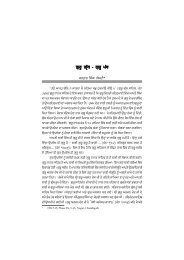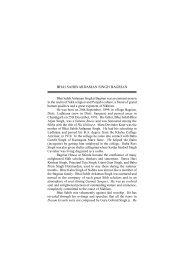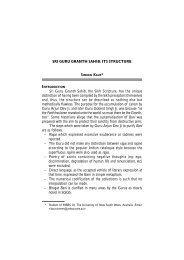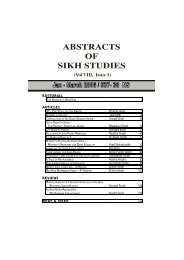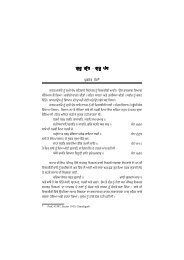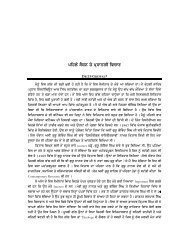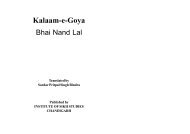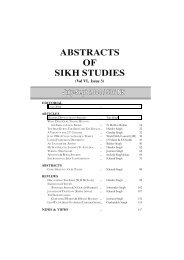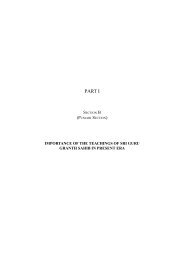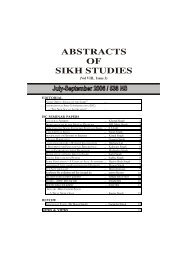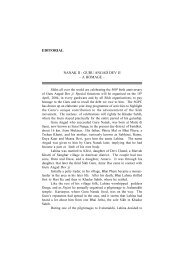editorial articles reviews news & views - Institute of Sikh Studies
editorial articles reviews news & views - Institute of Sikh Studies
editorial articles reviews news & views - Institute of Sikh Studies
You also want an ePaper? Increase the reach of your titles
YUMPU automatically turns print PDFs into web optimized ePapers that Google loves.
82<br />
ABSTRACTS OF SIKH STUDIES : APRIL-JUNE 2005 / 537 NS<br />
In connection with the last days <strong>of</strong> Guru Arjun or the early ones<br />
<strong>of</strong> Guru Hargobind, Fenech talks <strong>of</strong> “Jat castes”, the “militant nature<br />
<strong>of</strong> Jats” without any authority or justification. McLeod’s own work<br />
The Evolution <strong>of</strong> the <strong>Sikh</strong> Community, 1995, containing some untenable<br />
doctrines about the Jats, had not yet been published, and it does not<br />
find mention in the bibliography. Obviously, Fenech went by direction<br />
<strong>of</strong> his guide, McLeod, whom he could not refuse, though as stated<br />
earlier, Dr. Trilochan Singh, would have us believe that Jats at the time<br />
constituted hardly five per cent <strong>of</strong> the <strong>Sikh</strong> congregation.<br />
Guru Hargobind’s battles were fought only around 1634-35;<br />
therefore, the question <strong>of</strong> “highway men and robbers” joining Guru’s<br />
army at that earlier stage <strong>of</strong> Akal Takht, Lohgarh Fort or introduction<br />
<strong>of</strong> Dhad (martial) instrument, i.e. all before 1611, does not arise. The<br />
author mistakes Guru Hargobind’s construction <strong>of</strong> a mosque at<br />
Hargobindpura with the one at Kiratpur. All the way through Fenech<br />
goes on talking about ‘tradition’, ‘tradition’ and ‘tradition’, as if the<br />
Bhat Vehis even did not make history, or he thought it inadvisable to<br />
consult them.<br />
Fenech now talks <strong>of</strong> martyrdom <strong>of</strong> the ninth Guru Tegh Bahadur<br />
as if the fifth Guru, who was earlier martyred, was not a Guru. He<br />
garbles the account. He gives reference to Guru Tegh Bahadur’s<br />
compositions, without understandings their meaning. He mentions<br />
Guru Tegh Bahadur’s month long incarceration at Delhi in 1665, but<br />
does not elaborate on the only discussion he had with Aurangzeb. He,<br />
thereafter, immediately brings in the Kashmiri Brahmin’s delegation<br />
at Makhowal, though it was after another decade that that happened.<br />
Then follows the garbled version <strong>of</strong> Guru Tegh Bahadur’s martyrdom.<br />
The author brings in the peroration which later formed part <strong>of</strong><br />
Bachitar Natak on the significance <strong>of</strong> Guru Tegh Bahadur’s martyrdom<br />
as a unique act, performed for the sake <strong>of</strong> religious liberty and freedom<br />
<strong>of</strong> conscience. Fenech unnecessarily busies himself in time devoted<br />
to one Guru against another, without going into the import <strong>of</strong> what<br />
he said. However, Fenech is conscious that all the <strong>Sikh</strong> Gurus are<br />
“manifestation <strong>of</strong> the one divine light.” The word ‘tradition’ occurs<br />
several times without his conceding that Guru Gobind Singh’s writings



